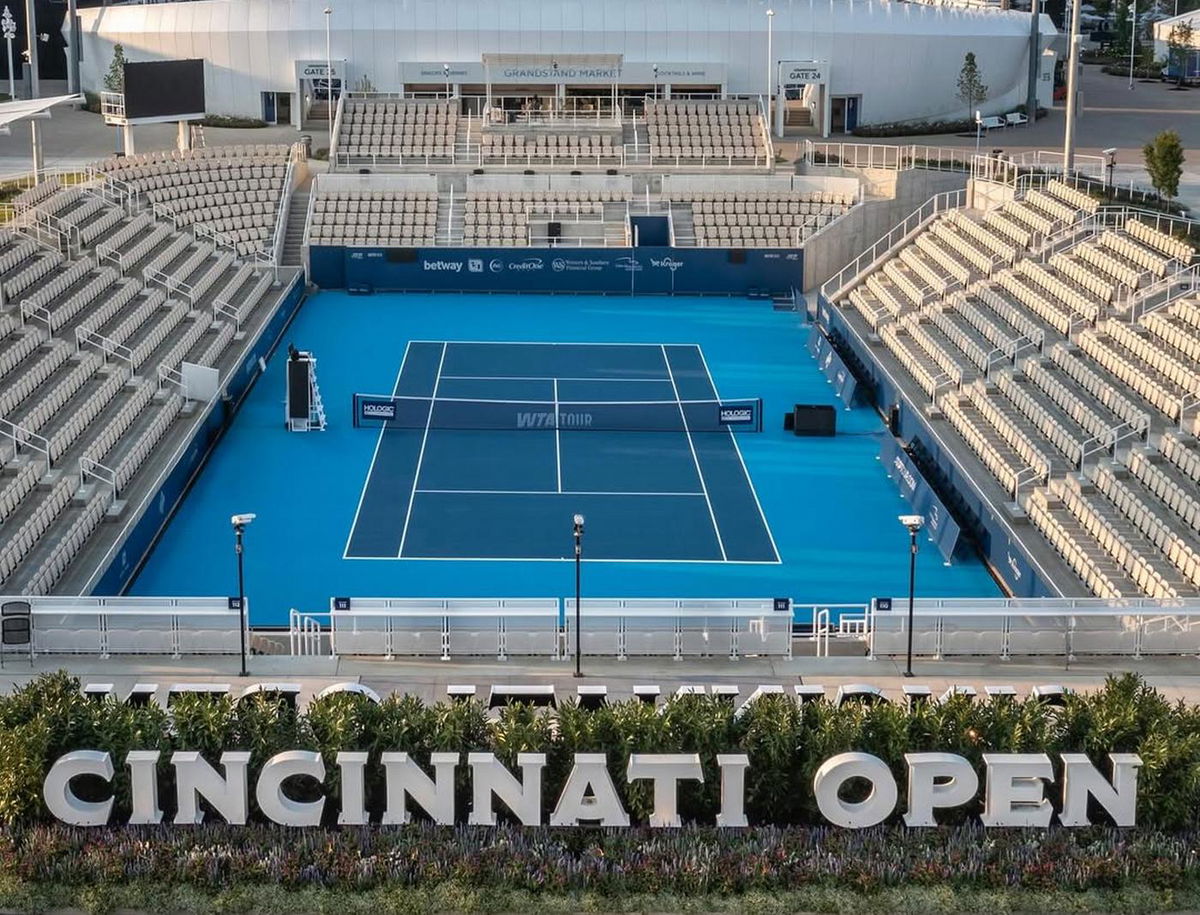
Imago
Image Credits: Cincinnati Open/Instagram

Imago
Image Credits: Cincinnati Open/Instagram
According to Tennis Connected on X, storms could crash the party. Literally. A study by AskGamblers warns climate change may hit the Cincinnati Open harder than any other U.S. tournament. The Lindner Family Tennis Center, the event’s long-time home, ranks among the most vulnerable venues to extreme weather in the years ahead.
Watch What’s Trending Now!
The forecasts? Grim. By 2026, almost half of all matches could be lost to climate-related disruptions. By 2033, 50.31%, the worst numbers for any U.S. tennis venue. And by the end of the century? A staggering 63% wiped out. That’s not just bad news for a Masters 1000. It could be an existential threat.
This should sound alarms for sport and climate alike. The Cincinnati Open, on the calendar for generations, may have to rethink everything. More weather-proof infrastructure. Smarter contingency plans. Maybe new scheduling altogether. Climate change isn’t just an environmental crisis anymore. It’s a sporting one, with the power to rewrite tournaments, player calendars, and the fan experience. The question isn’t if tennis must adapt. It’s how quickly.
ADVERTISEMENT
Climate change could cancel half of Cincinnati Open matches by 2033, new study warns.https://t.co/6VwScdPc11
— Tennis Connected (@TennisConnected) August 14, 2025
The signs have been impossible to miss this year. Early in the week, a scary moment arose. Arthur Rinderknech collapsed beside a shaded section during his round-of-32 match with Felix Auger-Aliassime. He had lost a tight first set in a tiebreak. The second set got tense. When Auger-Aliassime broke back for 2-2, Rinderknech grabbed a towel, tried to sit… and dropped onto his back. After receiving an MTO, it was of no luck, and the Frenchman retired, sending Felix through. But he wasn’t alone in feeling the heat.
Even former World No.1 Carlos Alcaraz has spoken about the brutal Ohio sun at the Cincinnati Open. Asked by Tennis Channel’s Prakash Amritraj how he manages, Alcaraz stayed cool and wise. “Well, sometimes we are just focused on ourselves. We’re just thinking that we’re struggling a lot with the heat, with the sun, with just feeling bad. And sometimes we forgot about the opponent. The opponent is struggling as well, or even much, much more than you are,” he said. Even Ben Shelton admitted to feeling “cooked out” during the day matches!
ADVERTISEMENT
As if the heat wasn’t enough for the Cincinnati Open, rain jumped in, too. Since Tuesday, players like Jannik Sinner, Alexei Popyrin, Andrey Rublev, Reilly Opelka, Francisco Comesana, Jasmine Paolini, and Ashlyn Krueger have sat through long delays. Some before their matches and others during, but the rain eventually can be handled. The heat? No such luck.
If the research proves right, players could face even hotter days here next season. This year alone has seen plenty of withdrawals and walkovers from the extreme heat. But Coco Gauff’s former coach believes there may still be a way around it.
ADVERTISEMENT
Brad Gilbert gives Cincinnati Open an idea to beat the heat
There’s one difference that sets the WTA apart from the ATP. On the women’s side, if the weather turns punishing, players get a 10‑minute break after two sets. Simple, fair, and in place everywhere. But in men’s tennis? Only a few events, like the US Open, offer the same. The rest leave players to battle it out, no matter how brutal the sun.
Brad Gilbert sees the gap and isn’t staying quiet. He posted on social media: “There isn’t a heat rule i believe @atptour level. The @WTA has something that there is 10 min break after 2sets, should definitely be something if to extreme no play, like they have in melbourne, or if over heat index 10 mins break after 2sets.” His point? The ATP needs to move before player health takes another beating. Even analyst Mike James pointed out after the Rinderknech incident, “Time for a heat rule on the men’s side?” signifying the urgency of the issue.
ADVERTISEMENT
On the flip side, while the tournament wrestles with wild weather, the stage itself has never looked more worthy of the spotlight. In just 11 months, the Lindner Family Tennis Center pulled off a jaw‑dropping $260 million upgrade to fit a bumper 96‑player draw. The revamp doubled the grounds to over 40 acres and added 14 fresh courts, pushing the total to 31. A transformation built to host more tennis than ever, though this week, even those sparkling new facilities have had to sit still for the rain.
Top Stories
Frances Tiafoe Makes Feelings Clear About Taylor Fritz After Brutal Clash: “Can’t Stand Him”

Line Call Drama Interrupts Venus Williams vs Madison Keys Match at Charlotte Invitational

“I’m So Embarrassed”: Serena Williams Opens Up About a Moment Only Tennis Players Understand

World No. 43 Announces Retirement After Infamous Stolen Trophy Incident at US Open

Novak Djokovic Approached a 6-Time Slam Legend for Coaching but Got a Brutally Honest Reaction

Now, with the Cincinnati Open rolling into its semifinals, the big question lingers: Will the heat or rain crash the party again? Only time will tell. But what’s your take on this? Share it in the comments below!
ADVERTISEMENT
ADVERTISEMENT
ADVERTISEMENT

